Marshalls Suds Design Guide
A few weeks ago, there was a post to The Brew Cabin Discussion Forum on the subject of permeable block paving which, as is the way with The Brew Cabin, wandered around a bit before settling into a discussion as to why we see so few installations, relatively speaking, when just a few years ago before the comedy driveway legislation was introduced, manufacturers were all but wetting themselves with excitement at what they predicted would be a huge upsurge in demand. After all, here was a government-driven statute requiring homeowners to have permeable paving, or so they thought, and then combine that with PPS25, the planning policy document that requires consideration of flood control for commercial developments, and you had the closest thing to a prescription for permeable paving it was possible to imagine. And think about it: with all those extra wide joints, the manufacturers would be able to sell less paving per square metre for more money! It was almost too good to be true.
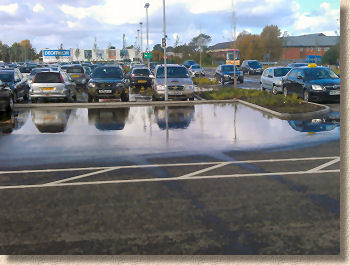
When things seem too good to be true, it's often because they are, and now we are a few years down the line, the industry has come to realise that despite permeable block paving, and concrete block permeable paving (CBPP) in particular, being a genuinely brilliant idea, it's a bit on the expensive side, so wily engineers and smart-arse contractors have found cheaper workarounds. Why would you install a double-normal-depth sub-base of dearer-than-normal crushed rock beneath a driveway if you could lay conventional paving and drain it to a hundred quid soakaway ? Similarly with the car parks for the epidemic of out-of-town retail parks and supermarkets that has infected the nation over the last decade: why would they blithely accept the additional costs of a technology that is still perceived (albeit wrongly) as unproven, when the supine local authorities will let them have blacktop and a settlement pond for almost no extra costs?
No matter how much development work has been done with CBPP, no matter how bleeding obvious it might be, getting developers and specifiers and homeowners to accept it and to implement it on their schemes is proving to be a massive hurdle, so anything that could help reduce the height of that hurdle has to be a welcome addition, doesn't it? To that end, Marshalls have just released their Permeable Paving Design Guide , a lavish, 64-page full-colour publication which aims to present a better case for CBPP and to guide the wary, the unfamiliar and the sceptical through the arcane lore that underlies this most radical of paving systems.
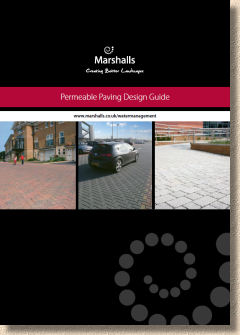
Why is it radical? It's just a leaky pavement, innit? In essence yes, but you have to appreciate the rules that have governed pavement construction since the Romans first decided to do something about the haphazard trackways that linked the various outposts of their burgeoning empire. And the most important of those rules was to get the water off the surface as quickly as possible and keep it out of the pavement structure. So roads were built using a gradation of finer and finer rocks and gravels, with a camber that directed water to the ditches or 'aggers' at the edges, where it couldn't compromise the carefully engineered build-up. That technology has proven effective for over 2,000 years and now, all of a sudden, we're telling clients to forget all that and let us send the water directly INTO the pavement instead, in a bold-faced contradiction of everything the civil engineering trade has held sacrosanct for millennia.
So, it's not hard to fathom why CBPP is struggling to be accepted, and that acceptance hasn't exactly been helped by the prevailing attitude amongst many of us in the industry who expected those who commission pavements to take our word for it and just let us build our confounding new type of driveway/access road/car park.

So: enter stage left, the new Design Guide which takes into account all of the above and aims to walk the wary through the labyrinth of CBPP, one baby step at a time. Everything about this guide seems to designed to inspire confidence amongst the sceptical and provide reassurance to the nay-sayer. And it all starts with a big double-page photie of Trafalgar Square in that London, with accompanying text which, when paraphrased, says " We did this. We've been doing this for 120 years. We know what we're doing. Trust us…we're Marshalls ".
This moves on to outline the issue, which is amply illustrated with photies of flooded roads, mud-covered car parks and sun-cracked surfaces, followed by what has to be one of the simplest and most straightforward explanation of Suds and its principles that I've ever read. It seems that as Suds as a technology matures, and the write-ups about it become refined, our vocabulary and syntax improves, and what was once an arcane lore is now becoming an easily-understood procedure. Each successive write-up in these design guides and manuals builds on what has gone before, and bit by bit, like muddy water trickling through a filter drain, we get an ever clearer picture of what it's all about.
There's a bit about legislation, but as this is just about the least clear aspect of Suds (after all, it's drawn up by useless politicos with their own power-maintaining agendas and arse-protecting civil servants desperate not to be held accountable for anything), it's mercifully succinct and short, referring readers to a bibliography at the back of the design guide. Finally, in this section on 'making the case' for Suds comes a neat summary and idealised illustration of the principal techniques.
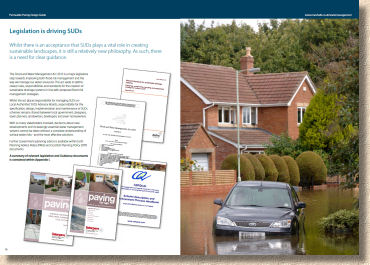
Next, we move a step closer to the actual purpose of a guide such as this, namely creating demand and shifting products, with a somewhat cursory examination of conventional versus permeable paving, and finally, the case for CBPP. It's taken 15 pages to get to this point, but it's been 15 pages of genuinely worthwhile content that should have eased the unfamiliar into accepting that Suds and CBPP are the way forward for many urban construction projects.
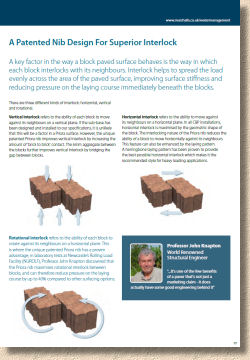
As identified earlier, the two biggest problems that has bedevilled CBPP since its inception have been the cost and the performance. No matter which way you look at it, CBPP costs more than conventional paving, and when you've paid that premium for a more environmentally-friendly surface, how can you be sure it will actually work? It would seem that Marshalls too have identified these key issues and have therefore devoted the following ten pages to assuaging your fears, cooling your fevered brow, and gently reassuring you that all of your concerns are unfounded. Look! There's the world's leading block paving expert, Prof. John Knapton saying summat nice, and an explanation on how they've skimped on the sub-base without adversely affecting performance. There's a very good explanation of the different types of interlock required to ensure a good block pavement (all of which applies equally to conventional and permeable constructions), plus a plug for the design and samples service, the web support, the CPDs and a couple of pages devoted to "Mythbusting".
So: on page 26 we finally find the meat in the sandwich (or nut roast if you're one of those pesky vegetablians); the products that the very nice people paying for all this careful explanation and illustration would be delighted for you to specify or purchase. Marshalls have cleverly lumped all the various formats of CBPP under the one brand umbrella: Priora. There has obviously been a conscious decision to have a permeable format of all the key product lines, so we get Priora in plain flavour (200x100), in decorative (Mistral shot textured), in Tegula (familiar sizes), and in Olde (distressed 200x100s)
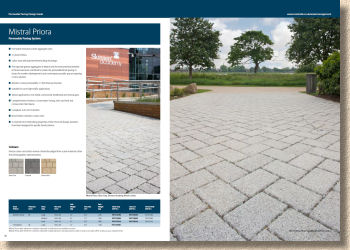
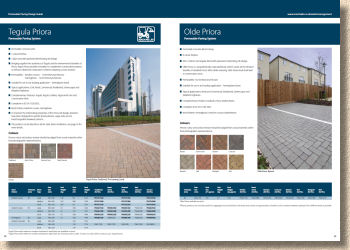
Each product is afforded at least a page, laid out in a format familiar to anyone who has browsed the various editions of Marshalls' Product Selector, with good quality photies, half-hearted swatches, and a clear table for key data such as sizes, packaging and product codes.
After a mere eight pages, two of which are given over to tanking membranes and aggregates, the fun is over and we're back on the hard stuff, the theory, the structural design procedure, the worked examples and the seemingly never-ending discussion about just what is the correct type/grading of aggregate for sub-bases. Again, all of this is lucid and easy to follow, but it's chuffing boring! Why can't we have more pretty pictures? I read this sort of thing day in and day out, and if I find it heavy going, think about the poor recently graduated engineer, crapping themselves over the risk of making an error. An oasis-like attractive photie of some lovely paving between each of the dry sections would have been extremely welcome.
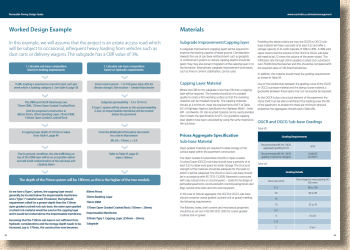
After a dozen pages of parched prose and dessicated examples, there's yet another under-illustrated section looking at the installation procedure. The explanatory text is understandably vague and non-specific, but of the five skimpy sized photies allegedly illustrating the techniques, none, with the possible exception of an ultra-boring close-up of a tanking membrane outfall, are unique to permeable paving. Certainly, any of the other four could have been used to illustrate a guide to conventional block paving.
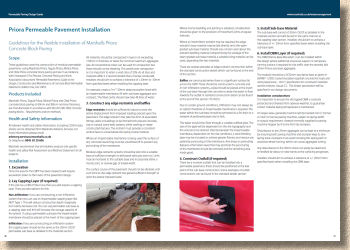
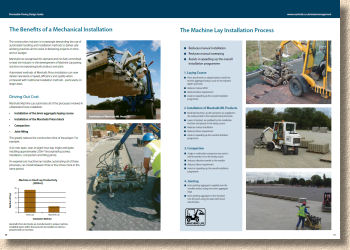
There's a couple of pages on machine installation, which are dignified by a generous slew of reasonably sized photies, one of which definitely features CBPP, but after reading through, I don't feel I've been convinced the ML is the way forward for block paving. For the last decade it has seemed to me that the two technologies offering a genuine future for CBPs are permeable paving and machine lay. When you combine the two, we should have the much sought-after killer app. This needs to be hollered from the (green) rooftops!
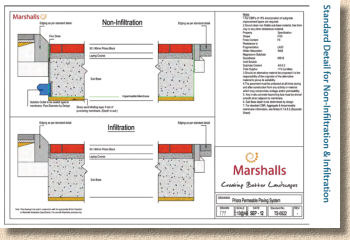
As we approach the end, there are perfunctory but necessary pages given over to maintenance, access for services and adoption by local authorities, rounded of with a good glossary and the aforementioned legal stuff appendix. And finally, a series of five cross-section drawings showing typical details for a range of what might be considered typical installations. The drawings seem fine, with a nice touch of colour, but in the PDF version I've been sent, the explanatory text is blurred no matter at what scale it is viewed.
So, what's the verdict? Well, it depends on what it is you want from this design guide. As an introduction to Suds in general and permeable paving in particular, it's as good as, if not better than, almost anything else out there just now. As a sales tool for Marshalls' products, it's desperately short on images. Photies sell paving, and while it's accepted than CBPP is a specialised market which requires a higher-than-normal degree of explanation, you can never have too many images.
There's no doubt that graduate engineers and architects tasked with the once in a decade paving project will find this to be invaluable, and I can't recommend it too highly for that audience. But for contractors? Mmmm....that's a bit tricky. There will be some who find it incredibly useful, and others for whom it will be nothing but gobbledegook. And as for homeowners – sorry: wrong brochure.
I think the key to understanding this publication lies in its title. It's a design guide and a bloody good design guide. It's not a sales aid nor a portfolio nor the sort of brochure that should be stashed on the dashboard or under the driver's seat of every Tranny van. However, if you want a better understanding of CBPP, then you'd struggle to find anything better than this.
Want to get a copy and make up your own mind?

